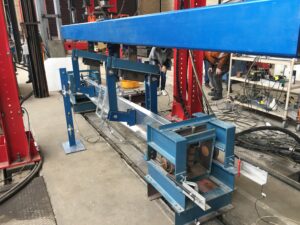Summary
BlueScope Permalite has demonstrated that it is possible to produce aluminium structural sections by roll-forming. This presents a faster and less energy consuming method of production than conventional extrusion. Through experiments and numerical simulations, the project develops guidelines for the design of single members and complete structural systems in cold-rolled aluminium. The project quantifies the strength enhancements achievable by the cold-rolling process and devises guidelines for determining the strength of cold-rolled aluminium sections and systems, considering the prevalent buckling modes for C- and Z-sections, their interactions and the effect of gradual yielding.
This Project is supported by the ARC Linkage Project LP140100863. The industry partner is Permalite https://permalite.com.au/, a subsidiary of Bluescope Lysaght.
Chief Investigators
- Prof Kim J.R. Rasmussen
- Dr Cao Hung Pham
PhD students and graduates:
- Dr Le Anh Thi Huynh
- Mr Ngoc Hieu Pham
- Mr Hoai Cuong Nguyen

Project outcomes and significance
The research in this project provides knowledge about the behaviour and strength of cold-rolled aluminium sections. In particular, it significantly broadens the understanding of column and beam behaviour subjected to local, distortional and/or flexural-torsional buckling. Extensive experimental programs are conducted along with numerical investigations to determine the ultimate strengths of sections, members and structural systems. No research had been conducted on cold-rolled aluminium sections prior to this project.
Current aluminium alloy structural design rules in the current American Specification and Australian Standard AS/NZS1664 Aluminium Structures are based on research on extruded aluminium members, which are known to be relatively thick due to limitations of the extrusion process. In this research project, the Direct Strength Method (DSM), which has been incorporated in international standards for cold-formed steel and stainless-steel structures, is proposed for cold-rolled aluminium sections. The principal benefit of this method is that the elastic buckling solutions for the entire member cross-section is used to provide the direct strength, rather than consideration of elements in isolation, as in the current design guidelines.
Three PhD students are assigned to the project to investigate the section capacity, member capacity and strength of portal frame systems, respectively. The investigations of section and member capacity included compression and bending, and the portal frame investigation considered frames subject to gravity loads and combined gravity and wind loads.

Publications
- A.T Huynh, C.H. Pham and K.J.R. Rasmussen, “Mechanical properties of and residual stresses in cold-rolled aluminium channel sections”, Engineering Structures, 2019, Vol. 199, doi.org/10.1016/j.engstruct.2019.109562.
- N.H Pham, C.H. Pham and K.J.R. Rasmussen, “Global buckling capacity of cold-rolled aluminium alloy channel section beams”, Journal of Constructional Steel Research, 2021, Vol. 176, doi.org/10.1016/j.jcsr.2021.106521.
- L.A.T. Huynh, C.H. Pham and K.J.R. Rasmussen, “Distortional buckling behaviour and strength of cold-rolled aluminium alloy beams”, Journal of Constructional Steel Research, 2021, Vol. 187, doi.org/10.1016/j.jcsr.2021.106980.
- N.H Pham, C.H. Pham and K.J.R. Rasmussen, “Design of cold-rolled aluminium alloy channel beams subject to global buckling”, Thin-Walled Structures, 2022, Vol. 180, doi.org/10.1016/j.tws.2022.109885.